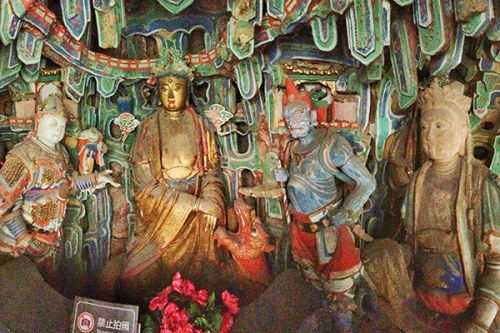
Buddhist statue inside Xuankong Temple. (Photo by Isidoro Ramirez/For chinadaily.com.cn)
Mineral-rich Shanxi offers much more for intrepid tourists.
As a business reporter for China Daily, I confess that the only thing I knew about Shanxi prior to my visit was that the province was rich in coal resources and the mining and chemical industries were the key economic drivers of the region. Such information is unlikely to appeal to the average traveler, but undoubtedly, Shanxi is a hidden treasure waiting to be discovered.
I wrongly assumed that mineral-rich Shanxi was an industrial hub with few tourist attractions but was pleasantly surprised to discover the province is a place to discover ancient Chinese culture and picturesque landscapes.
Locals boast that the province is one of the regions where Chinese culture originated and written records show that Shanxi's history dates back 3,000 years.
This is reflected in the fact that tourism is becoming the new engine for the province's economic development.
"Shanxi is making important investments to attract tourism and improve the quality of services that are being delivered," said Ma Bin, an official with the Municipal Committee Publicity Department of the city of Datong.
"The provincial government is working on opening new tourist attractions in the coming years so more people can discover our province," he said.
Shanxi is a mere three-hour ride by high-speed train from Beijing West Railway Station, but when you arrive at its capital city of Taiyuan you instantly notice a radical change of scenery and bold contrast with the capital's flat landscape.
The province's name derives from a combination of the Chinese words shan, meaning mountain, and xi, meaning west — referring to being west of the Taihang mountains.
The region in the north of China and in the middle reaches of the Yellow River is very mountainous and hilly, and thus offers many opportunities to venture into the highlands for trekking and climbing. It was not uncommon to see groups of travelers trekking across the green peaks as our group rode the bus between tourist attractions.
A sudden change of temperature announced our arrival at Wutai Mountain, located at the headwaters of the Qingshui river. Wutai benefits from a cold microclimate and has earned the name "Cool Mountain" because of its low temperatures throughout the year.
Of all the landscapes I saw during my trip, Wutai Mountain was probably the most striking because of its beautiful green fields and the mysticism that surrounds it.
The north peak of Wutai Mountain is the highest point in Shanxi province at an altitude of 3,058 meters. Chinese Buddhists believe the peak's high altitude can take you away from earthly concerns.
This is one of the reasons Wutai Mountain is regarded as one of four sacred mountains in Chinese Buddhism, and it is a favored destination for Buddhist pilgrimages.
Its green hills are a perfect place for a spiritual retreat as they integrate natural scenery, ancient architecture and folk customs.


















































